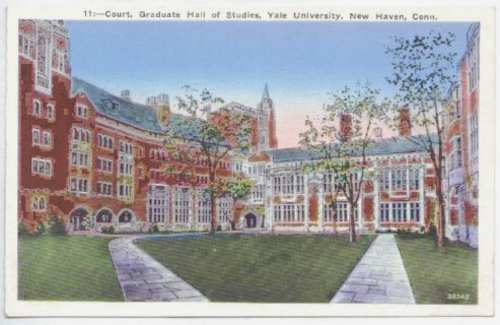James
F. Tierney Biographical
Notes
Former
next-door
neighbor in McLean,
VA
08/29/2006
bottom & links
INTRODUCTION
IG FARBEN WAR CRIMES TRIALS AT
NUREMBERG
Jim
Tierney was a fascinating neighbor. He arrived in Europe as
an
Army Lieutenant and
freshly-minted lawyer -- too late to fight the war, but just in time to
become the documentation officer at the Nuremberg trials of the
industrial chemical cartel, "I.G. Farben", which used slave labor to
power Hitler's war machine with synthetic fuel, munitions, artificial
rubber, nylon -- even the poison gas used to kill enemies of the state
and millions of Jews.
To
me, "IG Farben" was where my father worked when he was a Case Officer
at the Central Intelligence Agency's (CIA) Frankfurt station,
later in the 1950s. Because of Jim, I finally looked up what
all the fuss was about. The IG Farben story
is an amazing tale.
IG FARBEN RECONSTRUCTION
After the cartel was broken up, Jim worked with several of
the
"pieces" to protect their remaining infrastructure, secure scarce
materials, and restore their business and thus Germany's prosperity.
Members of the Boards of Directors at Cassela Farbwerke
Mainkur
(Frankfurt) and Bobingen AG für Textil-Faser
(near Augsburg) gave Jim gifts inscribed in memory of their common work
together.
You
knew Jim came from The Greatest Generation because he kept insisting he
wasn't anybody important. For me, Jim's generation embodied
the
greatness Americans can sometimes achieve because he -- one and the
same man from that generation -- could both prosecute the leading
figures of a foreign society for war crimes, and work with others from
the same set of leaders to rebuild their personal and
national
prosperity.
LEGAL CAREER
Jim became a prosecuting attorney for the Federal
Communications
Commission (FCC) in 1956, and was appointed by President Nixon in 1969
to serve as the FCC's administrative law judge. After
retirement
in 1990, he served as an arbitrator for the DC Bar and NASD, the
National Association of Securities Dealers, a quasi-private group set
up to regulate stock brokers etc. under the
Securities
Exchange Act of 1934. New York Stock Exchange self-regulatory
functions and NASD responsibilities were consolidated under FINRA,
the Financial
Industry Regulatory Authority, in 2007.
It
was difficult to pry
his stories out of him, but I tried anyway. Jim died 3 May 2009 (obituary). Please mail
me
your corrections, additions --- and memories. .
SKETCH OF JIM's EARLY
World War II YEARS
1940/1941: LEND-LEASE
Jim’s
parents had little money. Jim
did law school at night and worked days
at the British
Purchasing Commission,
which today is known for its airplane purchases -- so many, that it
stimulated the American aviation industry before the US was even in the
war. From Jim's point of view, the action wasn't just
airplanes. The Purchasing Commission was busy implementing
the Lend-Lease
Plan by commissioning the purchase of everything under the
sun, especially airplanes,
ships, lifeboats, lifeboat
divots, tanks, machine guns,
anything
iron or steel that looked like a boat or could be made into one.
Jim’s
born-in-Scotland
grandmother got him
into this historic $35-a-week
job.
Jim
completed his law degree at St.
John’s University
in Queens in 1941.
LEND-LEASE
BACKGROUND:
President Roosevelt recognized that the Fascist forces of Europe
would have to be stopped, but entering the war was politically
unpalatable to
most Americans until the Pearl Harbor
attack of Sunday,
7 December 1941.
This illustrates the adage that "Man cannot see the
writing on the wall until his back is against it."
Pearl
Harbor was Dec 1941, yet France
had fallen and England
was bombed in the Battle of Britain during the summer and autumn of
1940.
Lend-Lease provided $50.1B (nearly $700B in 2007 dollars) of
materials presented to the public as a loan or a lease.
Jim
did so well as the "bench boy" or go-fer
that the commissioners recommended him to the Henry J. Kaiser
Shipbuilding
company on Church
St. up around 87th or 90th
Ave.
That
office had opened in January
of
1942. Kaiser was
rich compared to Great
Britain, and Jim’s salary
went from $35/week
to $90/wk.
Jim
would have preferred to enlist in
the the Navy, but Chester W. Nimitz told him
his eyesight was terrible and the
Office
of Naval Personnel (which was what Nimitz ran at the time) wasn't going
to make
any exemptions. Handwritten letters from
Nimitz sell for
$1900 on eBay, a hand-addressed
envelope
is $400, so I told Jim to go
find this
autographed letter. Fleet
Commander Nimitz
rose to be Commander
in Chief of the Pacific Fleet in WWII and led the Battle of Midway
and the liberation of Guam.
1942-43: INTO
THE ARMY-AIR FORCE
In
1942, Jim volunteered to enlist one month early in
the Army-Air Force. After
struggling to
make his bunk in Ft. Dix
New Jersey
for 3 weeks, the Army
sent him to a
hotel in Atlantic City. The Army had commandeered
the hotels and
there weren't any maids or room service, but real beds were easier to deal with than
bunks in a barracks.
There
was a shortage of rifles to train with -- the other,
advanced troops got the 1903
Springfield
rifle, enlarged from 7 mm (about .28 caliber) to .30
caliber in 1906, and called the "30-ought
six" ever after. It
was the
best bolt-action
rifle ever made, and
beloved of snipers as late as the Viet
Nam
war.
Jim, unfortunately, got the old British Lee Enfield rifle
and complains
to this day it was too heavy. The Enfield
is .303 caliber.
ON
TO YALE & GLEN MILLER
People
poured into the Army, and Jim was
asked to help an intelligence unit
interview new recruits looking not only for criminality
but also for
Nazi sympathizers.
He was made a corporal and transferred to do more
interviews at Yale
University,
where he lived in
Graduate Hall.
Yale
courtyard,
from an old postcard
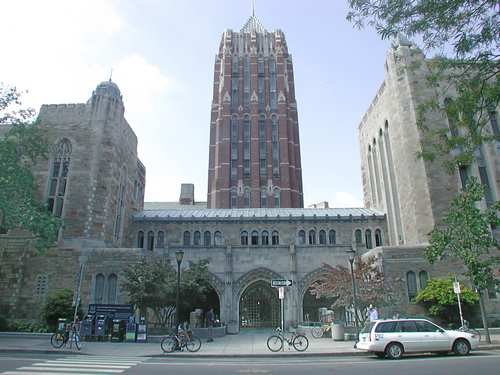
Entrance
to Yale
today
One
interviewee was the wife of Moe Purtill, Glenn
Miller's drummer, who was a German American and had to be checked for
Nazi sympathies. After
enlisting, Glenn Miller had established
a band that was billeted on the
University campus (1943-44) along with Jim. Miller's twenty-four piece
marching band,
which later grew to forty pieces, accompanied the cadets to the New Haven Green for
morning review and
evening retreat ceremonies.
Still
a corporal, Jim went to to Officer Candidate School
(OCS) in late 1943,
probably at Ft. Benning, Georgia. OCS had been cranking out
"90 Day
Wonders" (2nd Lieutenants), but just as Jim arrived
the course was put back to 120 days.
The fun and games included jumping off a tower into a tank
of water to
simulate abandoning ship if you got torpedoed on the high seas. By grabbing your barracks
bag (a lighter-weight
duffel bag) as you went down, you could fill it with air and use it for
flotation. Jim's
bag wound up around his
neck, and he had to be pulled out of the tank, but they passed him
anyway.
1944: INTELLIGENCE & THE B-24
By
February 1944, Jim was a 2nd lieutenant on his way to
the Combat
Intelligence School
of the US Amy Air Force in Harrisonburg
PA.
Intelligence for combat begins with learning to identify
military
aircraft as friend
or foe before
shooting them out of the sky. This
skill
was especially important for the heavy bomber crews pointing
anti-aircraft guns
at other planes.
Knowing
more than he ever wanted to about every plane in
the Japanese, German,
British and
American fighting forces, Jim transferred from
Harrisonburg to Fresno, CA for a couple weeks and then on
to Walla
Walla Washington,
where many heavy bombing
crews were being trained.
During
World War II the 2,164-acre Walla Walla Army
Airbase was developed as a training base for B-17
("The Flying Fortress") and B-24
aircraft ("The Liberator"), America's
two heavy bombers. During
the war
years, it was estimated that more than 8,000 officers were trained in Walla
Walla producing 594 heavy bomber crews.
Those crews completed
approximately
114,414 hours in
the air while
training. (See http://www.wallawallaairport.com/ownership/history.cfm
) Jim
thought the base
population overall was about 15,000 people when he was there.
(Contemporaneous air base archival
newspaper material at http://www.wallawallaairport.com/archives/article.htm
is neglected and unsearchable 7/09.)
Our
other WWII bombers were the B-25, small enough to
take off from aircraft
carriers, and the
B-26, used extensively on D-Day. The
B-26 was fast, but dangerous on takeoff if the crew was not
well-trained.
The
B-24 Liberator has 4 engines, a double tail and 50 caliber
machine guns -- not 30 like the British.
50 caliber guns can tear buildings and other planes to
shreds. The plane
had dual-barrel guns in the nose, in
the upper ball, and in the tail turrets, while the waist gunner manned
either
of two single guns pointing
out opposite
sides of the plane.
These are the days before "radar lock" and "missile launch".
If you want to get rid of an attacking plane, shoot it down yourself.
Jim
got lots of rides on B-24s and could still recognize Yakima,
Moses Lake
and places all over eastern Washington
State from
the air.
A
less enjoyable part of the work was recovering the
bodies of dead B-24 crews
who crashed
into the Blue Mountains on a weekly
basis, dying only 50
miles away and
often on night training
flights. Sometimes
the dead men were
from local states,
and Jim or others
from Walla Walla
had to accompany
the bodies home,
both to inform
relatives of the loss, and to see to it that the
coffins remained sealed, as the bodies were typically
destroyed and
burned beyond
recognition. (The
planes carried up to 3,600 gals of
aviation fuel.)
Crews
were typically 10 persons: pilot, co-pilot,
engineer, radio
operator, navigator, bombardier, nose,
ball, waist and tail gunners
The
war effort could sustain one or two B-24 crashes on
a weekly basis out at
Walla Walla,
as over 18,000 planes were built, although in
several variations. B-24s dropped over 630
kilotons of bombs --
the equivalent of 30 small atomic bombs.
(Hiroshima's
Little Boy
yielded 15 kilotons; Nagasaki's
Fat Man yielded 20 kilotons.)
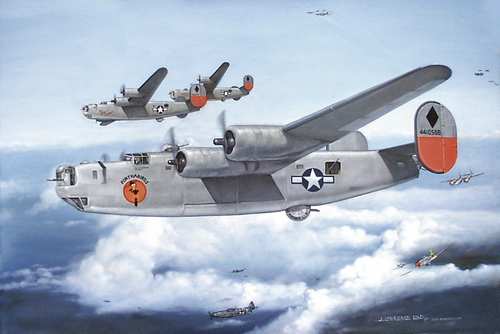
B-24 bombers.
Note the Plexiglas belly bubble, the mid-ships side-gun
(behind the wing)
and the tail
gun.
LATE 1944: OHIO
& FREEMAN FIELD, INDIANA
After
about 5 months in Walla Walla,
Jim transited through Wright Patterson
Field, Dayton
Ohio
to Freeman Field in Seymour
Indiana. A bomber group (40 to 50
aircraft) was formed
and training to go
to the Pacific from Walla Walla,
but Jim was split off from it.
Freeman
Field was a repository for captured foreign
aircraft, where they were flown, tested, and reverse-engineered
(formally, Freeman Field was home to the Foreign Aircraft Evaluation
Center of the US Air Force).
Enemy radar sets and even V-1 and V-2 rockets arrived at the
base.
TUSKEGEE
AIRMEN: Several all-black groups including
the Tuskegee
Airmen also trained
there, sometimes with public racial tensions on the base (recollected here, from
Disabled
American Veterans Magazine for Jan/Feb 2006).
Flying
out of their own separate airfields, the Tuskegee
Airmen flew P-51 Mustang
fighter escorts
for heavy bomber missions. Often
the bombers were flying into Germany across the Alps and the fighters
were coming up for escort duty out of small airstrips in the foothills
of northern Italy and Austria.
The
bomber
crews who came to love to see the fighter escorts come into sight often
never realized
their pilots were
black. This was
certainly the case for
one disabled B-24
crew shot up over Linz,
Austria
and forced to
make an emergency
landing on small
airstrip off the Adriatic in
northern Italy. Everyone that
rushed out to help the
disabled plane was black. On
that
occasion, one crew member refused to sleep in the black sleeping
quarters;
today, you couldn’t keep these men away from their reunions together. http://www.af.mil/news/airman/0202/crew.html
At
Freeman Field, Jim
liked running around on a forklift and was
caught stacking aircraft
engines and
upbraided because "officers don't work".
Jim made it to 1st Lieutenant anyway.
The
move from Walla Wall WASH
to Ohio
pointed Jim away from the
Pacific Theater and towards Europe.
Jan 1945: OFF
TO EUROPE
Promoted
to First Lieutenant, Jim
was sent through France
(with a brief visit to Paris)
to
then to Germany. Luxury transportation into
Frankfurt, Germany
was a
C-47, a noisy 2
engine plane with bucket
seats. With the Rhein-Main
Airport
bombed out of existence,
the rough flight ended with a rougher landing at a
steel-mats-over-mud
airstrip. Fighting ended in Europe only in the
first half of May, 1945.
BERLIN
and
MAJOR GENERAL WILLIAM DRAPER
Berlin
was
divided into four
occupied sectors, each
with a military governor from one of the
victors (Russia,
Britain,
France, USA).
These four governors together formed the Allied Kommandatura, which governed Berlin. Four flags flew
from the building, and guards from four nations' armed forced stood in
front.
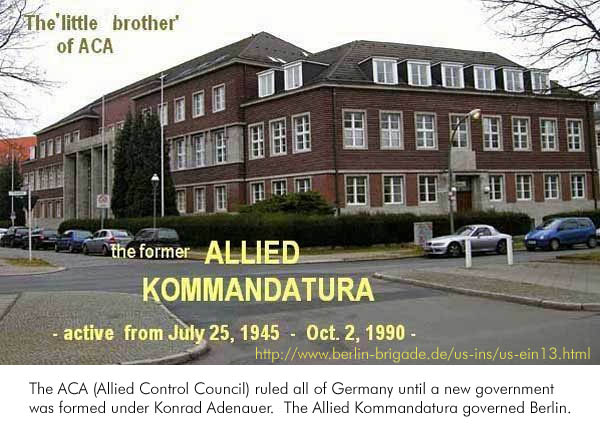
Whenever
Jim walked from where he lived to where he worked with
Draper, he passed the Kommandatura
building and everyone saluted him.
The
Allied Kommandatura was located in Dahlem/Zehlendorf, at 16-18
Kaiserswerther Strasse & Thielallee. It was returned
to the
Freie Universität Berlin, whose campus is in the neighborhood.
The Allied Control Council (ACA) occupied the much larger
home of
the German Supreme Court of Prussia, the 'Kammergericht'. (It
became the Kammergericht once again in 1994.) The
Kommandatura
governed Berlin, the ACA governed Germany as a whole, and, within the
ACA, the US Zone was governed by OMGUS, the Office
of Military Government, United States, under General Lucius D. Clay
The Americans, British,
and
French worked well enough
together, but the Soviet general (Marshal Vasily Sokolovsky) walked out
of the Allied Control
Council in
June of 1948 (the last meeting he attended was in March).. The other
Allies have
never officially accepted this walkout, and so, until the building was
given to the Free University of Berlin, you could see
the Russian flag still flying over the front door.
Jim
met his Russian counterparts on the de-cartellization commission and
partied afterwards at the Harnack Haus, home to the officers
canteen and many formal dances. Drinking with his Russian
counterpart meant standing to give (or receive) a toast, and downing a
shot of vodka in one gulp, if humanly possible. Jim was never
a
great drinker, but persisted because he enjoyed watching his opposite
number soften and start to share "comradeship" with a little "C".
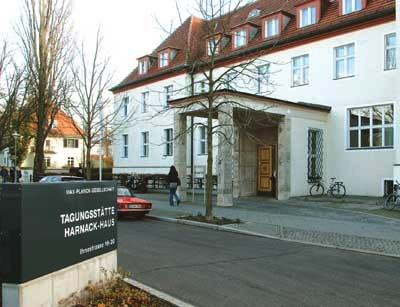 Harnack Haus, now
returned to the Max Planck Gesellschaft, successor to
the Kaiser Wilhelm
Institute
Harnack Haus, now
returned to the Max Planck Gesellschaft, successor to
the Kaiser Wilhelm
Institute.
With the founding of the Federal
Republic of German ("West Germany") in May, 1949, the
three western allies formed the successor to the ACA, namely
the High Commission of Germany. (JIN:
The High Commission
of German gave the
housing project where I lived as a child in Frankfurt
from 1952-57 its name, “HiCoG.
Americans still lived there in 1967, when I asked a lady
walking her dog
if it was still called “Hicog”. She
said
yes. “Do you know
that stand for?” “I
don’t know, just Hicog.")
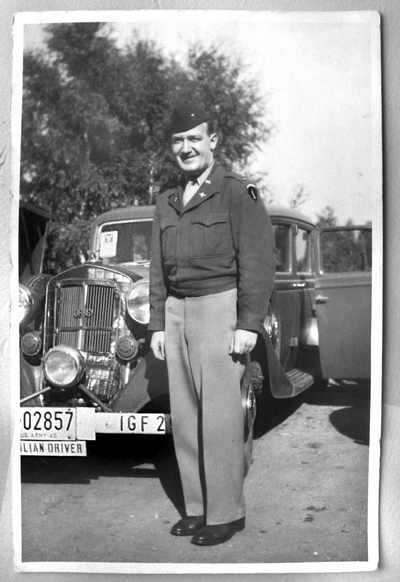 click
to enlarge
Jim
Tierney in Germany, ca. 1947
click
to enlarge
Jim
Tierney in Germany, ca. 1947
1945-46: THE
NUREMBERG TRIALS
Maj.
Gen. William Draper said Jim was needed at the
Allied I.G. Farben Control
Group
offices, so Jim went to Griesheim just outside of Frankfurt. (Jim, do you have a better
name than "Allied
I.G. Farben Control
Group" ?)
Besides
developing Zyklon B poison for the gas chambers,
I. G. Farben used SS
troops to run slave
labor camps, notably the buna rubber factory that
was a satellite to the Auschwitz
concentration camp. 25,000
laborers were
worked to death before they could get to the gas chambers for extermination.
The
I.G. Farben company
and the Hitler regime cooperated closely
on the financing, manufacture and supply of much war
material.
For this reason, the U.S.
wanted to break up the giant chemical industry cartel, convict its officers, and denazify
what remained. Jim
was needed to gather documentation for
these proceedings.
How
many billions in aid were given by the Federal
Republic of Germany in reparations to Jews for confiscated property and
the unpaid
wages of slave labor? Justice
is
imperfect, and the Germany Embassy turned repeatedly to the lawyer Peter Heidenberger as claims
of varying
validity were filed in the United
States
against Germany. Peter, as chance would
have it, turned out to
be a neighbor at Gwen and Jim’s beach house in Bethany Beach, DE.
For
more on Peter Heidenberger, see: From Munich to Washington: A
German-American Memoir
Kabel Publishers Inc.. Rockville,
MD 20852,
2004, 177pp. (Kabel Publishers Inc.. 11225
Huntover Dr, Rockville,
MD 20852-3613; tel/fax 301/468-6463)
1947-48: THE I.G.
FARBEN TRIAL AT NUREMBERG
I.
G. Farben was broken up in 1952 into:
- Agfa
- BASF
- Cassella
- Chemische
Werke Hüls AG, now Chemiepark
Marl
- Bayer
AG
- Hoechst
AG
- Duisburger
Kupferhütte AG, Kalle
- Wacker-Chemie
München
- Dynamit
AG Troisdorf,
and
- Wasag
Chemie AG
As
you can see, it was a pretty big outfit.
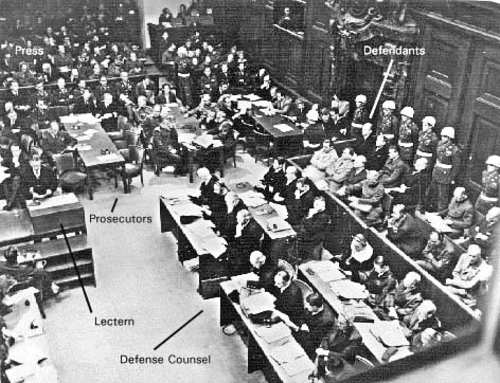
Overview
of the
Nuremberg Trials courtroom
The
I.G. Farben Trial at Nuremberg was held from 27 August 1947 to 30 July
1948.
Twenty-three
I. G. Farben executives came to trial in the
Nuremberg Trials and 12 or 13 received prison sentences. The executives who set up
the Auschwitz
III camp for buna
rubber manufacturing
where 25,000 people were killed got 6
years prison time for "enslavement".
They were Carl Frauch and Heinrch Buetefisch,
Director of IG Auschwitz; see http://de.wikipedia.org/wiki/IG_Farben).
Josiah
E. Dubois, Jr. was the deputy chief of counsel
for War Crimes in charge of the I.G. Farben case. Dubois wrote the
book, The
Devil’s Chemists (1952;
republished as Generals
in Grey Suits, 1953).
DuBois's book is critical
of the
outcome of the trial, and of Justice Morris's impact on it. According to
Joseph Borkin, the author of The
Crime and Punishment of I.G. Farben
(1978), as DuBois left the courtroom after the decision, he declared:
"I'll write a book about this if it's the last thing I ever do."
His
book is available on the Web:
http://www.spitfirelist.com/Books/dubois01a.pdf
for the first half of the book, up
to page 121 and http://www.spitfirelist.com/Books/dubois02a.pdf for pp 122 - end The
illustrations come after
page 78.
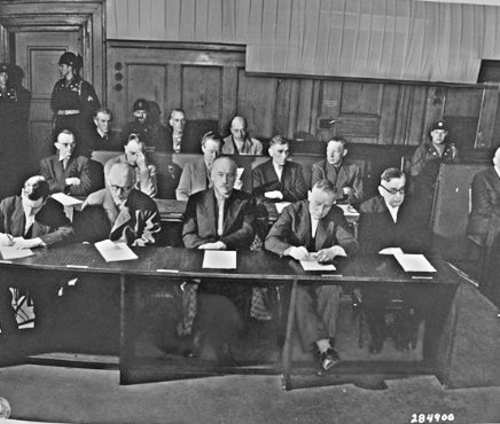
The
I.G. Farben
defendants at trial in Nuremberg
Borkin,
like Dubois, cites Justice Morris for being
impatient with the prosecution: Borkin writes that Morris
"voiced his
irritation with the proceedings"
and scolded the prosecutor: "This trial is being slowed down by a mass of contracts,
minutes and letters
that seem to have such slight bearing
on
any possible concept of proof in this case."
For
a modern scholarly treatment, see
http://www.court.state.nd.us/court/history/century/ii.k.htm
The
man who particularly wanted Jim was Edwin S.
Pilsbury, a wealthy lawyer from
California,
who told him, "Jim, we need you to take care of building up documentation for
trials at Nuremberg."
Jim
says, "The Germans convicted themselves. They
made copies of everything. They saved their copies in
salt mines. I went
there and told the
employees, 'Don't remove anything'.
Every document ended with 'Heil
Hitler' at the bottom."
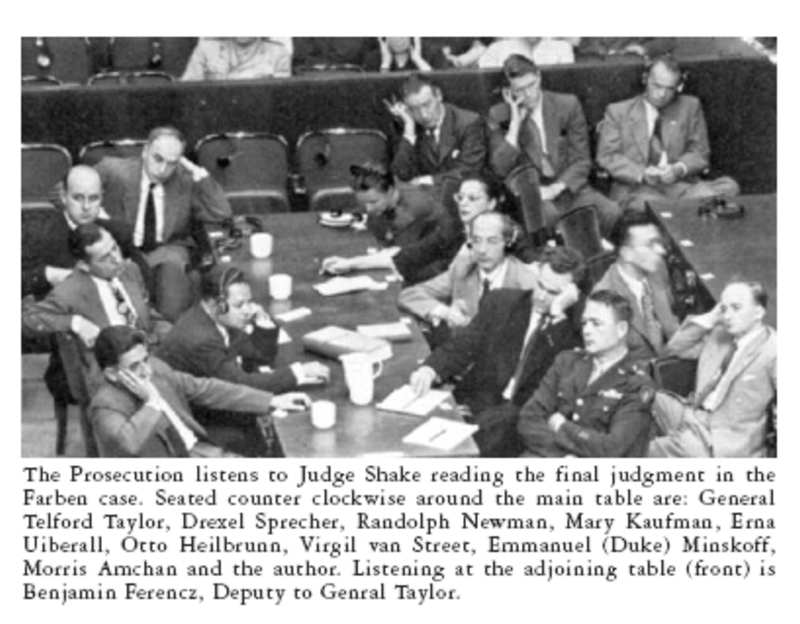
Nuremberg
Trials. The
prosecution table. From
DuBois’ book, The
Devil's Chemists.
Jim Tierney is the left-most of the three men
in the rear, listening to their simultaneous translation earphone. We could make a better scan
of this photo if
someone would dig out Jim's copy of DuBois’s book.
NUREMBERG TRIALS -- The I.G. Farben Case 27Aug1947 - 30Jul1948
The
proceedings run to 1400 pages and were available
from the Government Printing
Office:
TRIALS OF WAR CRIMINALS
BEFORE
THE NUREMBERG MILITARY TRIBUNALS UNDER CONTROL COUNCIL LAW No. 10 VOLUME VII
NUERNBERG, OCTOBER
1946 _ APRIL 1949
UNITED STATES
GOVERNMENT PRINTING OFFICE WASHINGTON : 1953
For sale by the
Superintendent of Documents, U. S Government Printing
Office Washington 25, D.C. - Price $4.75 (Buckram)
For
Web access: The Mazal Library,
http://www.mazal.org/archive/nmt/07/NMT07-F001.htm
or search in Google on
" related:www.mazal.org/NMT-HOME.htm "
The
complexities revealed by the trial at Nuremberg
of the I.G. Farben industrial cartel is thought by many to have been
Eisenhower's inspiration for his famous pronouncement upon
leaving the
presidency in 1961:
In
the
councils of Government, we must
guard against the acquisition of unwarranted influence, whether sought
or
unsought, by the military-industrial complex. The potential for the
disastrous
rise of misplaced power exists and will persist. We must never let the
weight
of this combination endanger our liberties or democratic processes.
TRIALS OUTSIDE NUREMBERG
Jim
says there were about 30 war crimes trials outside
of Nuremberg. Whereas Nuremberg
was run by the 4 Allied powers, the Americans alone
pursued such cases as the trial of Ilse Koch, the
"Bitch of Buchenwald," an SS officer's
wife who made lampshades out of the skins of prisoners,
among other
crafts.
Very
early after the war, there were also some extralegal executions.
Petty tyrants too small for the Americans to prosecute were
released, but sometimes they were released to partisans who took them
to a Displaced Persons camp whose residents knew them very
well.
Jim indicated they were promptly executed (murdered).
He
had never witnessed such an event in the camps, demurred that it was
mob violence, and said he believed the people in the camp were
immediately assembled, the person publicly accused, and shot on the
spot. (JIN: I had never heard of revenge killings
before.
Concentration camp survivors more often say they must not
sink to
the level of their captors.)
Jim: “I
was sent by my colonel to Munich
and passed the former Dachau concentration camp,
liberated by the 3rd
Army. The people
had nowhere to go
and were living in "DP Camps"
(Displaced Persons) near the old
concentration camps.
There were
several concentration camps in the Western
zones.”
Camps: Dachau
(American Zone, prosecution late 1945),
Bergen-Belsen
(British Zone, prosecution Nov 1945),
Sachsenhausen (Oranienburg),
Buchenwald.
Jim:
"At Stalin's request, thousands of Russian
POWs were forcibly returned to
Russia
in 1945 by the Americans. The
prisoners
were in handcuffs and leg irons,
because
they would rather run up on your bayonet and kill themselves than go back.
We loaded them onto transport cars.
What a terrible mistake.
When
they got back to Russia,
they were either killed or sent to Siberia."
Jim:
“A German Jew who came to America
as the war broke out returned to Germany
and participated in both the Nuremberg
trial of IG Farben and he worked
with me
afterwards as the company was split and its parts
reconstituted separately.
He was a lawyer in Berlin
and certainly knew German
law because he
taught it. In America,
he went the NYU
Law School. He went by the
name Randolph Newman in America,
and Rudolph Neumann in Germany. We were responsible for
the de-Nazification
of this industrial cartel, and this Jewish man overruled me. I would say ‘This man is a
Nazi and we have
the documents to show it’ and Newman or Neumann would say he was just a businessman, he
is so patrician. He
overruled me and let Nazi businessmen back
into German business.”
(JIN:
It seemed clear from Jim's
description that Newman longed for acceptance by the high
German
social elites he himself had once seemingly entered in liberal
Berlin, but ultimately had to
flee. In Marburg, Germany, the city tour guide
pointed out
to us in the '80s a building which written records
established as
Jewish property going back over 300 years. Three hundred
years is
longer than my country has existed as a nation, yet the German nation
turned on these, its own citizens, and rounded them up for
extermination. We can share Jim's eternal frustration with
his
superior Newman, but we should pause to reflect on the depth of the
man's confusion -- confusion about justice, loyalty, and even his own
identity.)
ff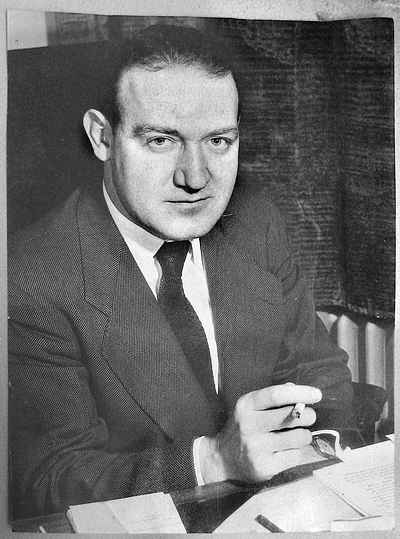 click
to enlarge
James
F. Tierney in Germany ca. 1949
click
to enlarge
James
F. Tierney in Germany ca. 1949
1948-51:
RE-INDUSTRIALIZATION AS THE COLD WAR LOOMS
Germany
faced starvation, a rising infant mortality rate, and limited resources
to get
thousands of unproductive people trapped in “”DP” (Displaced Persons)
camps out
of their of shacks and sheds and resettled into working, productive
lives. (JIN: A
fourth-grade outing of my
Army-American grade school took us to see a DP camp first hand. As late as 1953, it was
terrible, a
shanty-town of cold, muddy streets.
Now
I understood why our parents were always holding charity events for
“displaced
person resettlement” funds. But what I remember most was
my spinster
teacher trying to explain to the kids literally hanging on her skirts
afterwards, stunned and asking her, “Why do they have children if they
have to
live like that?” She
looked straight at
us and said, “Because maybe they think it can make them happy.” She hoped we would
understand. She
smiled patiently hoping we would
understand but we were young. There was nothing more
to say.)
The
Russians unbolted everything in East
Germany they could and
shipped it east. Russia’s
“bleed it white” policy also depopulated the rural countryside, a
demographic
change which the CIA tracked by counting newspaper reports of children
– and
even adults – killed by growing packs of wolves.
The French also confiscated industrial infrastructure,
while the British and especially the Americans increasingly saw the
need to get
Germany
prosperous again. The
initial intent –
before the Marshal plan – was to convert Germany
to an agrarian economy and save the world from war, which it was
believed only
Germans knew how to start.
When
Allied plans shifted to re-industrialization,
people were needed to supervise Germany’s largest, most powerful
chemical &
industrial corporate entities, to help them re-build and to ensure that
the
same bad players did not rise within them (“de-nazification”). Jim was one of the people
tapped to perform
this role, and he was urged to leave the Army and immediately re-enter
government service as a civilian.
Jim
had an inside-out familiarity with the most powerful chemical industry
players from
his work as “documentation
officer” for
the Nuremberg Trial
of Germany’s giants of the
chemical industry. He
became a true industry insider and wound up supervising many
of Germany’s
largest players in the chemical and pharmaceutical industries.
(Jim,
when did you leave the Army? Did
you go home and come back?
What rank did they give you to come back in?
GS-12?)
From
1945 to 1951, Jim supervised 45-50 different
companies in the U.S. Zone and in the U.S. Sector of Berlin. His authority was in some
respects above the
position of CEO and Chairman of the Board, as he was empowered to pass
on who
was appointed to either position. (JIN: It's a pity our own banking
industry has been handed over a trillion dollars with less supervision
than this.) His
“supervision” included protection and procurement.
For each company under his care, Jim was the
best liaison channel to
the American
Forces. Jim was in
a position to deflect
scarce supplies to “his” plants or secure needed transportation.
Nylon or Perlon? There was competition and cross-licensing
between DuPont and BASF over these two nylon variants
even before World War II. Jim's support enabled Perlon to emerge
as an early, successful driver of economic recovery in
Germany's post-war industrial chemical industries.
At
least two companies’ top officials were moved to give
Jim tokens of their appreciation for successful governance and
reconstruction
when Jim left in 1951.
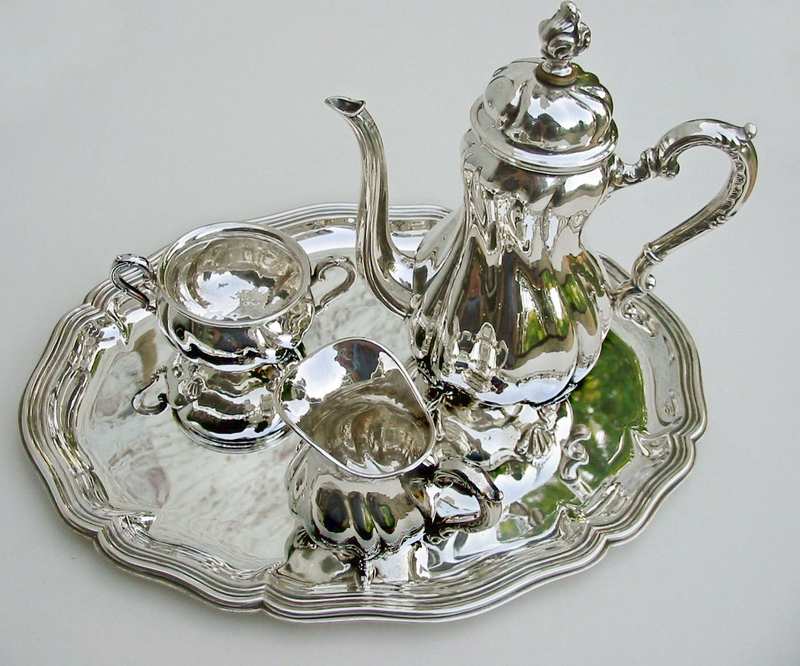
Coffee service given
by Cassela Farbwerke Mainkur (a former unit of the I.G.
Farben cartel in Nazi Germany) to the young American serviceman and
lawyer who supervised their "denazification" and reconstruction after
World War II.
The tray from Cassela Farbwerke
(Dye Factory) Mainkur Frankfurt/Main is inscribed
on the bottom
Zur Erinnerung,
1945-1951
Dr. Ch. K.
Dr. W.K.
J.M.D.
H.-B. N.
Prof. Dr. Zck
“Professor
Dr. Zck” is obviously Prof Dr. Werner
Zerweck, who went on to serve as the first post-war CEO of Farbwerke
Mainkur in
1952. The other
initials are harder to
find on the Internet.
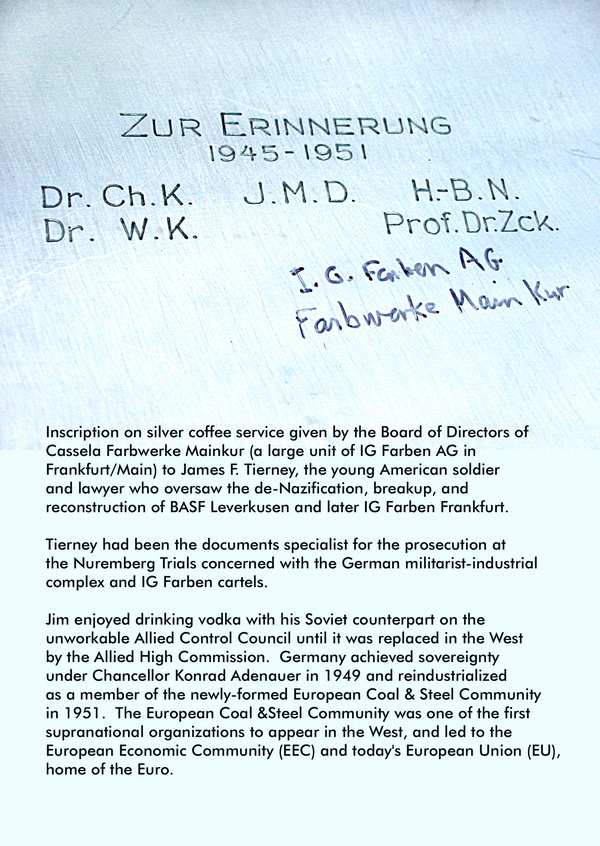
KICK-BACKS? NO WAY.
Tierney’s
straight-arrow reputation formed early.
One of the German managers in one of the
plants Jim supervised was bribed in US dollars, which were illegal
tender in Germany
at the time. The
person offering the
bribe had no trouble with that, because he was visiting from American
on behalf
of powerful interests. His
goal was to
get the manager to change the classification of dyestuffs to “damaged”. Germany
was the inventor and leading manufacturer of “coal-tar” or “aniline”
dyes, as
research into the byproducts of coal combustion in the steel industry
and
leading to the founding of a major branch of organic chemistry
generally. In any
event, getting these products labeled
“damaged” would have changed pricing and tariffs and generated 450 to
$100
million (Jim, in 1950 dollars?!!) in profits for those driving the
bribery.
The
man offering Jim’s manager the bribe had a powerful
law firm behind him and friends in Congress as well, all of whom threw
their
weight around, resulting in Jim being called onto the carpet before
General
Lucius Clay in Berlin. Clay was the father of the
Berlin Airlift and
rose from deputy to Eisenhower in 1945 to military governor of the U.S.
Zone
from 1947-1949, when he retired, so this event occurred in 1947-49. Jim had some of the
dollars used in the bribe
and recovered from the German civilian, which violated Clay’s own rules. Clay supported Jim and
ended the affair then
and there.
--end
of BIO sketch based on interviews
Jim was a Federal Judge, but did not sit on a Circuit
Court. Perhaps he
served on the U.S.
District Court for the District of
Columbia.
Judge Harold H. Greene, who broke up
AT&T, served on that court, and Jim knew him personally.
After
retirement, Jim reviewed many cases to
support the court
in deciding procedural
matters (rulings on motions to dismiss an attorney or accept a
particular
complaint as part of a lawsuit, or to accept a claim as suitable in
reckoning
damages). Many of
these cases involved
investments and securities.
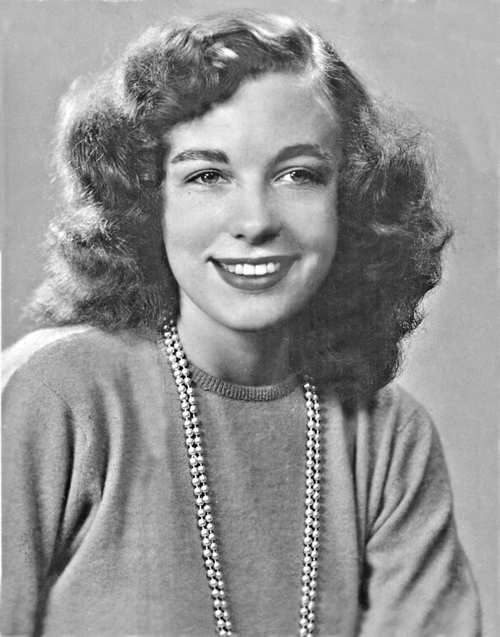
Gwen
Tierney, ca. 1951
As busy as Jim was down
in the salt mines retrieving hidden documents for
the Nuremberg Trials, he
also managed to find and court his lifetime companion, Gwen,
the
only daughter in an American Army family that left for Germany in 1947.
Jim
and Gwen were married in Arlington, VA, 26 December 1953, a year or two
after Jim returned from Germany. He obtained a job as
prosecuting
attorney for the FCC, and became an administrative law judge with the
Federal Comminications Commission (a Presidential Appointment) in 1969.
Jim remained in the Reserves and rose to Lt. Colonel, a move
which gave Gwen PX and Commissary privileges.
Upon
retirement from the FCC, Jim served as an arbitartor with the National
Association of Securities Dealers (NASD); Cases
often
involved disputes between investors and the brokers handling their
money. The NASD is the self-policing arm of the NASDAQ (NASD
Automatic Quotation system--a computer network, not an open-call
marketplace with real people). The New York Stock
Exchange
(NYSE; a real market taking place in a room) had a self-policing arm as
well. Both the NYSE and NASD self-regulators were combined
into
FINRA (Financial INdustry Regulatory Authority) in 2007.
The Authoritiy has been criticized from dropping the pursuit
of
violations as reflected in the drop in fines levied against violators
from nearly $150 million yearly to less than $50M/yr.
bottom & links to
other pages
-------------------------
BACKGROUND: Lend-Lease purchasing
Lend-Lease
Act was passed in March 1941. Washington
suddenly and unexpectedly terminated Lend-Lease on September 2, 1945.
Arthur
B. Purvis was made chairman of the Anglo-French
Purchasing Board in the
United States.
That Board drove (or became) the British
Purchasing Commission. Representatives
of other Commonwealth countries had representatives on the Commission. Sir Clive Baillieu was
Director General of
the British Purchasing Commission (but
possibly only in Australia?)
-------------
BACKGROUND:
Kaiser Shipbuilding
Henry
J. Kaiser's Kaiser Shipbuilding company got a
contract to build so many troop ships that he needed a new shipyard in Richmond,
California.
To prepare for constructing the new yard and the building
of ships that
would be much more complex than Liberty
ships, Clay Bedford opened a Kaiser office in New
York City in January 1942, and Dan
Peacock moved there
temporarily to start purchasing materials.
The old Liberty
ships consisted
of only 9,600 items, but the new C-4 troop transports would require a
much more
complex purchasing program, because each C-4 needed about 130,000 items. Bedford and Peacock hired
Jim Tierney to
help. Morris
Wortman, Kaiser's
chief facilities engineer, and Harry
Bernat, the marine design engineer,
also
came to New York
to start
designing the layout of the new California
shipyard.
-------------------------
BACKGROUND Glenn
Miller at Yale, 1943 - 1944
Glenn
Miller enlisted and formed a band.
Officially, they were the 418th
Army Air Forces Band from the Technical
School of
the Army Air Force Technical
Training Command stationed at Yale
University. Miller was in
charge of forming all the bands for the Army Air Force
Technical
Training Command. He surveyed the recruits
passing through Atlantic City
for basic
training to spot any musicians, and assigned the best to
his own
band.
On March 30, 1943, the 418th AAF Band settled
into their quarters at 58 Lake Place, the
former dormitories of Yale art students.
Three months later, they moved to
Durfee Hall in the Old Yale Quadrangle.
A twenty-four piece marching
band, which later grew to forty pieces, accompanied the
cadets to the New Haven Green for morning
review and evening retreat ceremonies.
-------------------
BACKGROUND: Glenn Miller's
drummer, Moe Purtill & his wife Nance Flake
[
Red Norvo Orch ] b. March 31, 1908, Beardstown,
IL Theme Song:
"Mr. and Mrs.
Swing" (This song represented the
fact that the 'girl' vocalist, Mildred
Bailey, was also Red's wife.)
Mildred
and Red co-directed their own orchestra during
the 1936 to 1939 years. Mildred, who was part Native American, was
probably one
of the two or three greatest pop and jazz singers of her day. Her
brother was
Al Rinker, one of
Whiteman's 'Rhythm
Boys'(along with Bing Crosby and Harry
Barris). Red had a great little band which finally
disbanded due to
friction between the sidemen and Red's wife.
Red
was a soloist with the Paul Whiteman Orch in the
late 20's. By 1935, he had a sextet that was playing the Famous Door
club in
NYC. By 1936, he was fronting a 'big' 10 piece band (really the
augmented
sextet) at the Syracuse
Hotel (Syracuse, NY).
The girl singer was Nance Flake, who later
married Moe Purtill, Red's drummer.
In
1938, Moe Purtill moved to the Glenn
Miller band and greatly invigorated it.
Murtill
was still with Miller at Yale in 1943, when his wife had to be grilled
by
intelligence cadet James Tierney to asses her loyalty.
After
singer Nancy Flake left for Glenn Miller’s
orchestra, Mildred Bailey, Red's wife took over the singing chores for
his
band. A lot of tongues were
wagging when Red married
Mildred due to Red being a 'white' man and Mildred
was a Native American woman. Mildred's voice was
absolutely lovely, but the bandsmen found her not an easy person to get
along
with.
---------------------------------------------
top of this BIO page
a military burial at Arlington Cemetery
obituary
some Tierney family photos
background on IG
Farben industrial cartel which Jim prosecuted at
Nuremberg
home for this Website
(such as it is)
JIN
Rev 13May09, 30Jul09 17Aug09 +2 photos of Jim in 1940s,
Rev Jan19 email, link to.german-hosiery-museum nylon/perlon story for 1951
